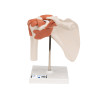### Anatomy of the Shoulder
The shoulder is one of the most complex and highly mobile body joints, allowing for a wide range of movement. It consists of three bones and several muscles and tendons:
1. **Bones:**
- **Scapula (shoulder blade):** A triangular bone that connects with the collarbone and the humerus.
- **Clavicle (collarbone):** Situated between the sternum (breastbone) and scapula, it stabilizes the shoulder.
- **Humerus (upper arm bone):** Fits into the scapula at the glenoid, forming the main shoulder joint.
2. **Joints:**
- **Glenohumeral Joint:** The main joint of the shoulder, where the humerus inserts into the scapula's glenoid cavity.
- **Acromioclavicular (AC) Joint:** Where the clavicle meets the acromion of the scapula.
- **Sternoclavicular (SC) Joint:** Where the clavicle meets the sternum.
3. **Muscles and Tendons:**
- **Rotator Cuff:** A group of four muscles (supraspinatus, infraspinatus, teres minor, and subscapularis) that stabilize the shoulder and allow for rotational movements.
- **Biceps Brachii:** Involved in flexing the elbow and stabilizing the shoulder during overhead activities.
- **Deltoid:** The large muscle that covers the shoulder, crucial for arm abduction.
4. **Ligaments:**
- **Glenohumeral Ligaments:** Stabilize the main shoulder joint.
- **Coracoacromial Ligament:** Connects the coracoid process to the acromion of the scapula.
- **Coracoclavicular Ligament:** Connects the clavicle to the coracoid process of the scapula.
### Biomechanics of the Shoulder
The shoulder's biomechanics are designed to provide stability while allowing a tremendous range of motion, which includes flexion, extension, abduction, adduction, internal rotation, and external rotation.
- **Range of Motion:** The shoulder's ball-and-socket design allows for the arm to move in almost any direction.
- **Stability vs. Mobility:** While the shoulder is highly mobile, it's also prone to injury. The rotator cuff muscles play a critical role in stabilizing the shoulder during movement.
### Common Shoulder Issues
- **Rotator Cuff Injuries:** Tears or inflammation can occur from overuse or acute injury.
- **Dislocation:** High mobility makes the shoulder prone to dislocation.
- **Frozen Shoulder:** Involves stiffness and pain in the shoulder joint.
- **Impingement:** Occurs when shoulder muscles rub against the top part of the shoulder blade.
### Utilization of Shoulder Models
In medical education, physical therapy, sports science, and orthopedics, detailed models of the shoulder are used to teach anatomy, demonstrate common pathologies, and simulate surgeries. In research, biomechanical models help in understanding the effects of various movements and can assist in the design of better treatments and preventive measures for shoulder-related issues.
If you need more detailed information on any specific aspect of the shoulder model, such as surgical approaches, specific exercises for rehabilitation, or detailed biomechanical analysis, feel free to ask!

1300 × 865
Source:https://www.123rf.com/photo_40885144_shirtless-male-model-looking-over-shoulder.html

590 × 542
Source:https://anatomywarehouse.com/body-parts/upper-lower-limbs/shoulder/shoulder-models/

500 × 500
Source:https://www.southernbiological.com/anatomical-model-life-size-of-shoulder-joint/

1174 × 2444
Source:https://www.mdpi.com/2813-0413/1/1/5

400 × 600
Source:https://www.nytimes.com/2023/03/28/style/big-shoulders-trend.html

480 × 640
Source:https://www.youtube.com/watch?v\u003dva6jTeQCxxo

300 × 875
Source:https://ota.org/for-patients/find-info-body-part/3832

100 × 100
Source:https://www.nebraskascientific.com/joint-models/1370-functional-human-shoulder-joint-3b-smart-anatomy.html

324 × 432
Source:http://classroom.sdmesa.edu/anatomy/ModelPages/upper_extremity.htm

1800 × 1800
Source:https://radsource.us/off-track-shoulder-lesions/
